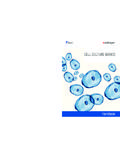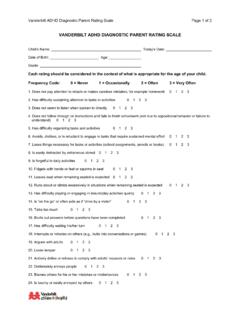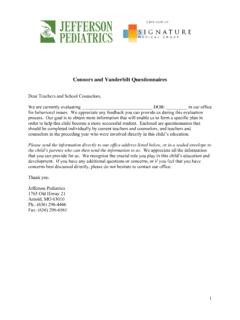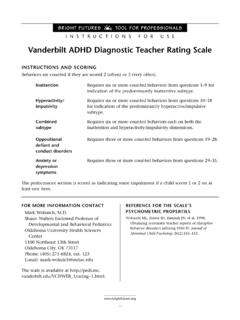Transcription of Scoring Instructions for NICHQ Vanderbilt Assessment Scales
1 CARING FOR CHILDREN WITH ADHD: A RESOURCE TOOLKIT FOR CLINICIANS, 2ND EDITION. Scoring Instructions for NICHQ Vanderbilt Assessment Scales The validation studies for the NICHQ Vanderbilt Assessment Scales To meet DSM-IV criteria for the diagnosis, one must have at least were for the 6 to 12-year-old age group. However, to the extent 6 positive responses to the inattentive 9 or hyperactive 9 core that they collect information to establish Diagnostic and Statistical symptoms, or both. A positive response is a 2 or 3 (often, very Manual of Mental Disorders, Fourth Edition (DSM-IV) criteria, they often) (you could draw a line straight down the page and count the are applicable to other groups, particularly preschoolers, where positive answers in each subsegment).
2 There is a place to record the they have identified that DSM-IV criteria are still appropriate. number of positives in each subsegment. These Scales should not be used alone to make a diagnosis of ADHD The initial Scales have symptom screens for 3 other comorbidities: without confirming and elaborating the information with interviews oppositional-defiant disorder, conduct disorder, and anxiety/. with at least the primary caregivers (usually parents) and patients. depression. (The initial teacher scale also screens for learning You must take into consideration information from multiple sources. disabilities.) These are screened by the number of positive Scores of 2 or 3 on a single symptom question reflect often-occurring responses in each of the segments.
3 The specific item sets and behaviors. Scores of 4 or 5 on performance questions reflect problems numbers of positives required for each comorbid symptom screen in performance. set are detailed below and on the next page. The initial Assessment Scales , parent and teacher, have 2 components: The second section of the scale has a set of performance symptom Assessment and impairment in performance. On both measures, scored 1 to 5, with 4 and 5 being somewhat of a problem/. parent and teacher initial Scales , the symptom Assessment screens problematic. To meet criteria for ADHD there must be at least 2. for symptoms that meet criteria for inattentive (items 1 9) and items of the performance set in which the child scores a 4, or 1 item hyperactive (items 10 18) attention-deficit/hyperactivity disorder of the performance set in which the child scores a 5; ie, there must (ADHD).
4 Be impairment, not just symptoms, to meet diagnostic criteria. The sheet has a place to record the number of positives (4s, 5s). Parent Assessment Scale Teacher Assessment Scale Predominantly Inattentive subtype Predominantly Inattentive subtype . Must score a 2 or 3 on 6 out of 9 items on questions 1 9. AND . Must score a 2 or 3 on 6 out of 9 items on questions 1 9. AND. Score a 4 on at least 2, or 5 on at least 1, of the performance questions 48 54. questions 36 43.. Score a 4 on at least 2, or 5 on at least 1, of the performance Predominantly Hyperactive/Impulsive subtype Predominantly Hyperactive/Impulsive subtype . Must score a 2 or 3 on 6 out of 9 items on questions 10 18. AND . Must score a 2 or 3 on 6 out of 9 items on questions 10 18.
5 AND. Score a 4 on at least 2, or 5 on at least 1, of the performance questions 48 54. questions 36 43.. Score a 4 on at least 2, or 5 on at least 1, of the performance ADHD Combined Inattention/Hyperactivity ADHD Combined Inattention/Hyperactivity Requires the criteria on Inattentive AND.. Requires the criteria on Inattentive AND. Hyperactive/Impulsive subtypes Hyperactive/Impulsive subtypes Oppositional-Defiant Disorder Oppositional-Defiant/Conduct Disorder . Must score a 2 or 3 on 4 out of 8 behaviors on questions 19 26. AND . Must score a 2 or 3 on 3 out of 10 items on questions 19 28. AND. Score a 4 on at least 2, or 5 on at least 1, of the performance questions 48 54. questions 36 43.. Score a 4 on at least 2, or 5 on at least 1, of the performance Conduct Disorder.
6 Must score a 2 or 3 on 3 out of 14 behaviors on questions 27 40. AND. Score a 4 on at least 2, or 5 on at least 1, of the performance questions 48 54. A S S E S S M E N T A ND DIAGNOSIS Page 1 of 2. Scoring Instructions for NICHQ Vanderbilt Assessment Scales Parent Assessment Scale Teacher Assessment Scale Anxiety/Depression Anxiety/Depression . Must score a 2 or 3 on 3 out of 7 behaviors on questions 41 47. AND Must score a 2 or 3 on 3 out of 7 items on questions 29 35. AND.. Score a 4 on at least 2, or 5 on at least 1, of the performance questions 48 54. questions 36 43. Score a 4 on at least 2, or 5 on at least 1, of the performance . Learning Disabilities Must score a 4 on both, or 5 on 1, of questions 36 and 38. The parent and teacher follow-up Scales have the first 18 core Scoring the follow-up Scales involves tracking inattentive ADHD symptoms and the comorbid symptoms oppositional-defiant (items 1 9) and hyperactive (items 10 18) ADHD, as well as the (parent) and oppositional-defiant/conduct (teacher) disorders.
7 Aforementioned comorbidities, as measures of improvement over The Performance section has the same performance items and time with treatment. impairment Assessment as the initial Scales ; it is followed by a side- effect reporting scale that can be used to assess and monitor the presence of adverse reactions to prescribed medications, if any. Parent Assessment Scale Teacher Assessment Scale Predominantly Inattentive subtype Predominantly Inattentive subtype . Must score a 2 or 3 on 6 out of 9 items on questions 1 9. AND Must score a 2 or 3 on 6 out of 9 items on questions 1 9. AND.. Score a 4 on at least 2, or 5 on at least 1, of the performance questions 27 33. questions 29 36. Score a 4 on at least 2, or 5 on at least 1, of the performance.
8 Predominantly Hyperactive/Impulsive subtype Predominantly Hyperactive/Impulsive subtype . Must score a 2 or 3 on 6 out of 9 items on questions 10 18. AND Must score a 2 or 3 on 6 out of 9 items on questions 10 18. AND.. Score a 4 on at least 2, or 5 on at least 1, of the performance questions 27 33. questions 29 36. Score a 4 on at least 2, or 5 on at least 1, of the performance . ADHD Combined Inattention/Hyperactivity ADHD Combined Inattention/Hyperactivity Requires the criteria on Inattentive AND Requires the criteria on Inattentive AND. Hyperactive/Impulsive subtypes Hyperactive/Impulsive subtypes . Oppositional-Defiant Disorder Oppositional-Defiant/Conduct Disorder . Must score a 2 or 3 on 4 out of 8 behaviors on questions 19 26.
9 AND Must score a 2 or 3 on 3 out of 10 items on questions 19 28. AND.. Score a 4 on at least 2, or 5 on at least 1, of the performance questions 27 33. questions 29 36. Score a 4 on at least 2, or 5 on at least 1, of the performance . The recommendations in this publication do not indicate an exclusive course of treatment or serve as a standard of medical care. Variations, taking into account individual circumstances, may be appropriate. Original document included as part of Caring for Children With ADHD: A Resource Toolkit for Clinicians, 2nd Edition. Copyright 2012 American Academy of Pediatrics. All Rights Reserved. The American Academy of Pediatrics does not review or endorse any modifications made to this document and in no event shall the AAP be liable for any such changes.
10 A S S E S S M E N T A ND DIAGNOSIS Page 2 of 2.








